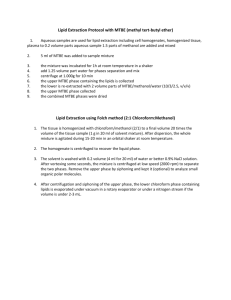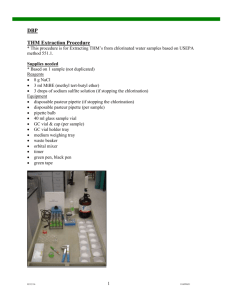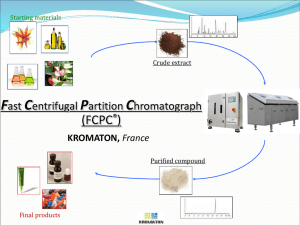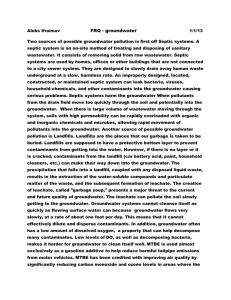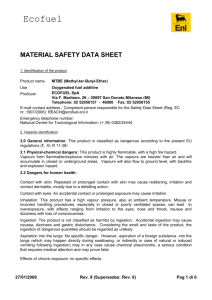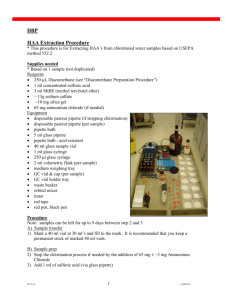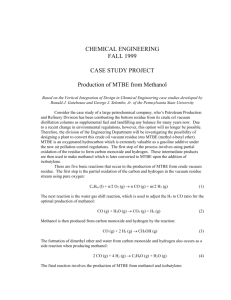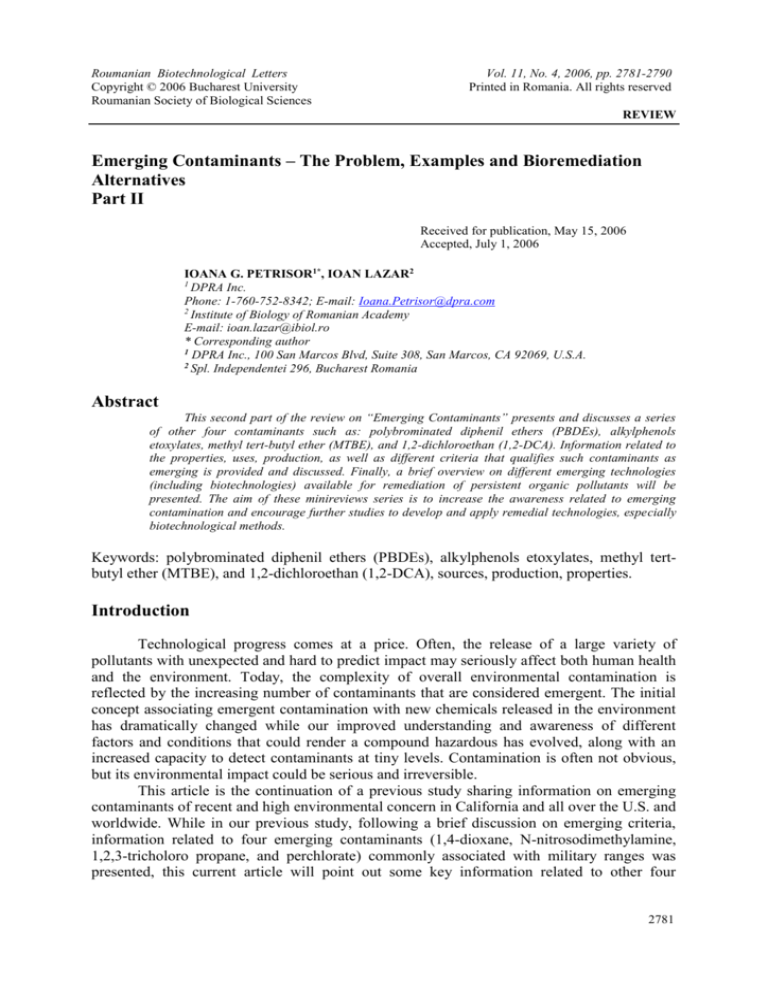
Roumanian Biotechnological Letters
Copyright © 2006 Bucharest University
Roumanian Society of Biological Sciences
Vol. 11, No. 4, 2006, pp. 2781-2790
Printed in Romania. All rights reserved
REVIEW
Emerging Contaminants – The Problem, Examples and Bioremediation
Alternatives
Part II
Received for publication, May 15, 2006
Accepted, July 1, 2006
IOANA G. PETRISOR1*, IOAN LAZAR2
1
DPRA Inc.
Phone: 1-760-752-8342; E-mail: Ioana.Petrisor@dpra.com
2
Institute of Biology of Romanian Academy
E-mail: ioan.lazar@ibiol.ro
* Corresponding author
1
DPRA Inc., 100 San Marcos Blvd, Suite 308, San Marcos, CA 92069, U.S.A.
2
Spl. Independentei 296, Bucharest Romania
Abstract
This second part of the review on “Emerging Contaminants” presents and discusses a series
of other four contaminants such as: polybrominated diphenil ethers (PBDEs), alkylphenols
etoxylates, methyl tert-butyl ether (MTBE), and 1,2-dichloroethan (1,2-DCA). Information related to
the properties, uses, production, as well as different criteria that qualifies such contaminants as
emerging is provided and discussed. Finally, a brief overview on different emerging technologies
(including biotechnologies) available for remediation of persistent organic pollutants will be
presented. The aim of these minireviews series is to increase the awareness related to emerging
contamination and encourage further studies to develop and apply remedial technologies, especially
biotechnological methods.
Keywords: polybrominated diphenil ethers (PBDEs), alkylphenols etoxylates, methyl tertbutyl ether (MTBE), and 1,2-dichloroethan (1,2-DCA), sources, production, properties.
Introduction
Technological progress comes at a price. Often, the release of a large variety of
pollutants with unexpected and hard to predict impact may seriously affect both human health
and the environment. Today, the complexity of overall environmental contamination is
reflected by the increasing number of contaminants that are considered emergent. The initial
concept associating emergent contamination with new chemicals released in the environment
has dramatically changed while our improved understanding and awareness of different
factors and conditions that could render a compound hazardous has evolved, along with an
increased capacity to detect contaminants at tiny levels. Contamination is often not obvious,
but its environmental impact could be serious and irreversible.
This article is the continuation of a previous study sharing information on emerging
contaminants of recent and high environmental concern in California and all over the U.S. and
worldwide. While in our previous study, following a brief discussion on emerging criteria,
information related to four emerging contaminants (1,4-dioxane, N-nitrosodimethylamine,
1,2,3-tricholoro propane, and perchlorate) commonly associated with military ranges was
presented, this current article will point out some key information related to other four
2781
IOANA G. PETRISOR, IOAN LAZAR
emerging contaminants: polybrominated diphenyl ethers – PBDEs, alkylphenols etoxylates,
MTBE and 1,2-DCA.
Polybrominated Diphenyl Ethers (PBDEs)
Polybrominated diphenyl ethers (PDBEs) – commonly used as flame retardants –
represent an example of emerging contaminants that are classified as emerging based on their
increased detection in humans. Thus, in 1998, researchers in Sweden reported something
alarming: PDBEs have been detected at increasing concentrations in breast milk. Practically,
their concentration has doubled every two to five years for the past 25 years. Moreover, due to
the current environmental legislation banning the use of PCBs, PDBEs concentration is
constantly increasing while PCBs concentration is decreasing. The propensity to accumulate
in fat tissues of living organisms, along with their persistence in environment and toxicity
classify PDBEs as emerging contaminants and as the possible PCBs of tomorrow. More
information on PBDEs can be found on various websites:
(http://www.ecy.wa.gov/programs/eap/pbt/pbde/PBDE_main.htm);
(http://www.rand.org/scitech/stpi/ourfuture/GameChangers/emergingcontaminants.html).
At the same time, PBDEs may be consider emerging due to other causes such as
toxicological data linking them to liver, brain and thyroid problems in laboratory rodents [1,
2]. Their health effects on humans are still poor understood. Yet, the increasing
concentrations in water supplies and human body, among which the highest concentrations
may soon trigger the laboratory effects observed so far in animals at levels just slightly higher
than the highest human reported levels.
As more and more of the common consumer products containing PBDEs as flame
retardant are dumped into landfills, the risk for contaminating the water supplies increases.
Luross & al. [3] noted an 100-fold increase in PBDEs in Lake Ontario trout between 1978 and
1998, while recent research by Schecter & al. [4] found levels of PBDEs in U.S. women to be
10-100 times higher than reported levels in European women.
Properties
Similar with PCBs, there are 209 PBDE congeners named in analogy to PCBs. From
these, only 7 congeners comprise about 95% of PBDEs. Being similar in chemical structure,
they have similar properties with PCBs, so they are highly lipophilic with tendency to
bioaccumulate in fat tissues. They are persistent in the environment and their resistance to
degradation increases as bromination increases (penta-BDE>>Octa-BDE>Deca-BDE).
There are three common commercial products of PBDEs: penta-BDE, octa-BDE and
deca-BDE (deca comprising 80% of the worldwide use). Penta-BDE is the most
bioaccumulative form, with the highest production in North America.
Production and Uses
PBDEs are used as flame retardants in a large variety of commercial products
including textiles, foam products, lubricants, electrical equipment, building materials and
transportation. Examples of common products containing PBDEs are: textiles (clothing,
carpets, curtains, tents, interior for offices and public buildings, seating for amphitheaters,
stadiums, glass fiber products) and furniture, as well as circuit boards in consumer electronics,
like TVs and computers (about 40% of PBDEs are used in the outer casings of computers,
2782
Roum. Biotechnol. Lett., Vol. 11, No. 4, 2781-2790 (2006)
Emerging Contaminants – The Problem, Examples and Bioremediation Alternatives
Part II
printers and TVs, with the highest PBDE in the mixture as deca-BDE), or electronic switches,
relays and molding filers. PBDEs are also connected with transportation, being present in
textiles, seat cushion and covers, printed circuit board assemblies, transformers, capacitors
and other components of passenger cars, buses, trucks, aircraft, subways and ships. The
plastic parts in coffee makers of hair dryers, some medical and laboratory equipment, some
building materials (insulation materials, translucent and glass fiber panels, switches, cables,
capacitors, etc.), and paints (flame retardant paints and flame retardant joint fillers) also
contain PBDEs. Their presence in the housings of printers, fax machines, photocopiers,
keyboards and modems is also common.
The global production of PBDEs is over 40,000 tons a year. Great Lakes Chemical
Company is the sole U.S. manufacturer that has announced that they will phase out some
formulations by 2005.
Alkylphenol Etoxylates
Although chemically different, alkylphenol ethoxylates have similar environmental
fate with PBDEs. Thus, chemicals of this group are persistent, bioaccumulative and toxic.
Recently, there have been many concerns regarding the environmental safety of alkylphenol
ethoxylate surfactants, particularly regarding weather their metabolites are able to mimic
hormones. Alkylphenol ethoxylates may be biodegraded to a series of metabolites, such as
alkylphenols, that are generally more toxic and tend to accumulate in living organisms and
interfere with human hormones. By instance, alkylphenols were first found to be oestrogenic
in the 1930s, but the implications of these effects were only highlighted in recent research by
Warhurst [5]. Nonylphenols are well-known endocrine disruptors that can make cancer cells
proliferate, particularly those cells sensitive to oestrogen. Thus, the growth of cultured human
breast cancer cells is affected by nonylphenol at concentrations of only 1 uM (220 ppb), and
by octylphenol at 0.1uM (20 ppb). Oestrogenic effects have also been shown on rainbow trout
hepatocytes, chicken embrio fibroblasts and a mouse oestrogen receptor. In an 1995 Report by
Warhurst [5], it was concluded that the current environmental levels of alkylphenolic
compounds are probably high enough to be affecting the hormonal control systems of some
organisms, with possible effect on human health, too. This conclusion was based on the
environmental concentrations, bioconcentration factors and in vitro oestrogenic effect levels
of alkylphenol ethoxylates. Still, little is known on the potential health effects of these
compounds. The hormonal effects are best evaluated probably by using cell culture, while
more research is needed to establish other potential toxic mechanisms that may involve the
immune or the nervous system.
The use patterns of these surfactants, which range from individual household type
applications to large-scale industrial processes, result in their discharge to the environment via
sewage treatment plants as well as directly from untreated effluents. There is recent alarming
data related to their occurrence into indoor air of U.S. homes. Overall, alkylphenol
ethoxylates are a group of chemicals that do not degrade adequately in swage treatment,
persist in environment, breakdown to more toxic, more persistent and more lipohilic
intermediates that bioaccumulate and may have oestrogenic effects at current environmental
concentrations. All these are clear traits of emerging contaminants.
Properties
Roum. Biotechnol. Lett., Vol. 11, No. 4, 2781-2790 (2006)
2783
IOANA G. PETRISOR, IOAN LAZAR
Alkylphenol etoxylates are non-ionic surfactants, consisting of a branched-chain
alkylphenol which has been reacted with ethylene oxide, resulting in an ethoxylate chain. The
length of the ethoxylate chain varies between 1 to 50 ethoxy units, depending on their
application. Commercial formulations are complex mixtures of homologues, oligomers and
isomers. According to White & al. [6], the main commercial alkylphenols are nonylphenol
ethoxylates (NPnEO – 80% of the world market) and octylphenol ethoxylates (OPnEO – the
remaining of about 20% world market).
Alkylphenol ethoxylates are more or less liphophilic compounds [7], This leads to
their bioconcentration into fat tissues. In the higher organisms, the bioconcentration levels
may include biomagnification through the food chain, and also uptake of contaminated
sediment (with higher levels than the water) [8].
Alkylphenol etoxylates may be biodegraded by removal of the ethoxy groups,
producing less biodegradable products such as: alkylphenol mono- and di-ethoxylates,
alkylphenoxy acetic and alkylphenoxypolyethoxy acetic acids, as well as alkylphenols. These
metabolites frequently persist through swage treatment and in rivers, while anaerobic
conditions generally lead to alkylphenols accumulation. Also, these metabolites of
alkylphenol ethoxylates are generally more toxic than the original compounds and accumulate
in organisms, with bioconcentration factors varying from ten to several thousands, depending
on metabolite, species and organ.
Production and Uses
For over 50 years, they were used in a variety of industrial (including wool washing)
and domestic applications [9] as cleaning agents and surfactants.
Their main use today is as industrial surfactants, though they still have some domestic
uses, by instance the spermicide nonoxynol-9 according to Soto & al. [10]. They are
important to a number of industrial processes including: pulp and paper manufacture, textile
manufacture, antioxidants/stabilizers for polymers, emulsion polymers, coatings, agricultural
pesticides, lube oils and fuels, laundry detergents, hard surface cleaners, packaging materials,
refrigerator lining, thermoplastic polymers, water-based paints, tire and rubber manufacture,
household cleaners, adhesives, foam control agents, resins, institutional cleaners
(http://www.aperc.org/productinfo.htm). Industrial application comprises 55% of market,
while industrial and institutional cleaning products comprises about 30%, and household
cleaning products 15%, with less than 1% for other uses.
Alkylphenol ethoxylates, in particular nonylphenol and octylphenol ethoxylates, are
widely used non-ionic surfactants. Worldwide, the annual production in 1997 was reported to
be in excess of 500 ktons [11], with one tenth of this produced in China. The annual
production of approximately 200,000 tonnes was recorded in the United States in 1988.
MTBE
MTBE is a gasoline additive used in order to reduce air pollution by contributing to a
more complete combustion and improve engine performance. It was first commercially used
in gasoline in Italy in 1973. Later on, in 1979 MTBE started to be added to gasoline in the
U.S. to replace the lead and prevent knocking (usually between 1-8% by vol.). The use of
MTBE as gasoline additive increased in time as a result of more strict air regulations. By
instance, the U.S. Clean Air Act of 1990 required the use of oxygenates in reformulated
gasoline (2.7% oxygen by weight equivalent to 15% MTBE) [12]. Premium gasoline typically
contains more MTBE than the regular one and, in total MTBE accounts for approximately 4%
2784
Roum. Biotechnol. Lett., Vol. 11, No. 4, 2781-2790 (2006)
Emerging Contaminants – The Problem, Examples and Bioremediation Alternatives
Part II
by vol. of all gasoline in the U.S. [13]. Today, MTBE is used worldwide with an annual
consumption of approx. 24 billion liters, the U.S. using approx. 60% of the MTBE produced,
Europe about 15%, and the remaining 25% are used in the rest of the world. Apart from its
presence in gasoline, MTBE is also present in fuel oil, diesel, kerosene and other middle
distillates, due to the transportation of the petroleum products in the same pipelines and trucks
[14, 15].
However, leaking petroleum storage tanks with associated piping and spillages have
caused MTBE to get into the groundwater where it was detected all over USA and worldwide.
The first major contamination event, which brought public attention to MTBE happened in
Santa Monica, CA. Thus, in 1996, the city learned that two of its drinking water well fields
were contaminated with MTBE at levels as high as 610 ppb, and had to shut down the two
wells accounting for 50% of city’s drinking water. At present, more than 20 public drinking
water wells in California have ceased water production for similar reason.
Once in the groundwater, it takes only little amount of MTBE to render the water
unusable for drinking because of the added taste and smell. MTBE increasing detection in
water wells, associated with its resistance to biodegradation and offensive taste and odor at
low levels, were raising many concerns related to the true benefits of using MTBE in fuels
and classify it as emergent contaminant, sparking the national controversy between the need
to reduce air pollution and the necessity to safeguard precious water sources from
contamination(http://www.epa.gov/mtbe/faq.htm).
The health effects of MTBE are only partially understood. Thus, the majority of
human health researches were focusing on effects caused by the inhalation of the chemical
and have not concluded about the imminent public health threat posed by MTBE-oxygenated
gasoline. There is limited data on MTBE effects caused by ingestion and on a long-term basis.
EPA’s Office of Water has concluded that available data are not adequate to estimate the
potential risks of low-exposure to MTBE in drinking water. However, the existing data
support the conclusion that MTBE is a potential human carcinogen at high doses. Although it
is less toxic than other gasoline constituents, the short and long-term effects of MTBE
exposure in humans are not known.
Properties
MTBE is a colorless, flammable organic liquid with a strong taste and smell
noticeable at only 15 ppm level. MTBE has a relatively high vapor pressure (so a high
volatility) and water solubility. It does not adsorb to soil particles and thus may travel through
soil fast and contaminate the groundwater. It is much more soluble in water than most other
petroleum constituents and subsequently will travel long distances with groundwater, getting
further from the source area than other petroleum compounds. MTBE has a specific gravity
lower than 1, thus will float on the water. When exposed to air, MTBE evaporates readily.
MTBE, as other gasoline constituents, has a vapor density greater than air, and thus will tend
to sink and accumulate in low areas (such as basement or utility trenches) in the absence of
pressure or temperature gradients.
MTBE is generally resistant to biodegradation. Yet, there is one well-documented
study of natural MTBE biodegradation under iron-reducing conditions (see Landmeyer et al.,
[16]), but the removal rate, although statistically significant, was very slow and probably
limited by the supply of biologically available iron in the aquifer sediment. There is no
indication, to date, of MTBE degradation in sediments under sulfate-reducing conditions. In
general, the research rather shows MTBE resistance to biodegradation in most environmental
Roum. Biotechnol. Lett., Vol. 11, No. 4, 2781-2790 (2006)
2785
IOANA G. PETRISOR, IOAN LAZAR
conditions. It is generally considered that the rate of natural bioattenuation of MTBE is much
slower than the rate of benzene bioattenuation, in the case the MTBE was shown to degrade at
all.
Production and Uses
Since 1979, MTBE was produced for use as gasoline additive (in place of lead)
designed to reduce the air pollution, by reducing the carbon monoxide and ozone emissions
(increasing burning efficiency) and boosting the Octane ratings of gasoline. It helps gasoline
meet the government’s clean-air regulations that restrict vehicle emissions, especially in
warmer weather climates.
Other minor uses of MTBE include its medical use to dissolve gallstones in humans
by injection, with no toxic injuries of the patients reported so far. MTBE has also been used in
analytical laboratories as an extractant and to a minor extent, in chemical synthesis (e.g.,
hydrolyzed to produce tert butyl alcohol - TBA). MTBE can be thermally decomposed into
methanol and isobutene and in the past has been used to produce isobutene.
Available statistics show a dramatic increase in MTBE production from the 1980s to
the early 1990s and a slower, but steady, increase in production during the 1990s. In the U.S.,
four states (California, Louisiana, Michigan, and Texas) account for over 50% of the total
number of reporting MTBE disposal facilities.
In the U.S., annual MTBE production estimates for 1991 were 9.57 billion pounds
(4.34 billion kg), and estimates for 1992 were at 10.86 billion pounds (4.92 billion kg). The
estimated production capacity during 1995 was 240,100 barrels (about 62.2 million pounds or
28.2 million kg) per day. Since some companies operate plants that make large contributions
to the total annual U.S. production of MTBE, production estimate statistics may exclude
figures from certain companies. In fact, such private providers of production information as
SRI International no longer provide any MTBE production quantities for facilities or
companies. Only limited quantitative estimates on annual import and export levels for MTBE
are available for years prior to 1994. For 1994, the level of MTBE imports was 1.753 billion
kg (3.865 billion pounds); the level of exports for 1994 was estimated as 0.405 billion kg
(0.893 billion pounds). The annual production volume of MTBE in the year 1997 in the EU
was 3 030 000 tonnes.
1,2-Dichloroethane (1,2-DCA)
1,2-DCA also referred to as “lead scavenger” (to encourage greater volatility in the
lead combustion by-products to be exhausted from the vehicle) was additive of leaded
gasoline until the late 1980s when leaded gasoline was phased out. Although it has not been
used as additive to gasoline since more than a decade, recent studies indicate the possibility
that this compound may persist in the environment and affect drinking water supplies. And,
since it has had and still has other uses, the source of lead scavengers in the environment
remains unclear. 1,2-DCA has been found increasingly in groundwater and soil near landfills
and industries using large chemical quantities. Thus, the risk for contaminating drinking water
supplies is high. Moreover, it is present in homes in some cleaning solvents, pesticides, glues,
varnishes, and strippers, with the risk to contaminate the indoor-air also high.
Considering its health effects, EPA has found that 1,2-DCA can cause central nervous
system disorders, adverse lung, kidney, liver, circulatory and gastrointestinal effects on a
short-term exposure. The long-term exposure has the potential to cause cancer from a lifetime
exposure at levels above the MCL. Animal studies to date suggest that 1,2-DCA causes
stomach, lung, breast and other types of cancer. EPA currently classifies 1,2-DCA as a
2786
Roum. Biotechnol. Lett., Vol. 11, No. 4, 2781-2790 (2006)
Emerging Contaminants – The Problem, Examples and Bioremediation Alternatives
Part II
“probable human carcinogen”. With a widespread occurrence and persistence in the
environment, along with potential carcinogenic effects as well as other effects on human
health, 1,2-DCA may certainly be added to the list of emerging contaminants.
Properties
1,2-DCA is a colorless, oily, organic liquid with a sweet, chloroform-like odor, that
does not occur naturally in environment. It evaporates very quickly (at normal temperatures)
from water and soil releases into the atmosphere, where it is diluted and carried long
distances. It may be broken down into less-toxic compounds in the atmosphere. It can leach
into groundwater rapidly where it is likely to persist for a very long time. If the compound
reaches deeper soils or groundwater where it does not break down, it can travel long distances
and can enter drinking water wells. It can be detected by odor in water at about 20 ppm, and
in air at about 10-50 ppm.
It is generally resistant to biodegradation, but not expected to accumulate in fish.
However, evidence of biodegradation exists and, as in the case of the other emerging
contaminants presented, we are still limited by our knowledge in understanding the true
potential for biodegradation of such compounds and the right environments in which this may
occur. Thus, 1,2-DCA biodegradation was successfully put in evidence by carbon isotope
fractionation among substrate, inorganic carbon, and biomass during an aerobic
mineralization by Xanthobacter autotrophicus according to Hunkeler and Aravena [17] . The
stimulated anaerobic biodegradation of both 1,2-DCA and MTBE was also demonstrated by
Kinder Morgan and ARCADIS at a field scale, at a large storage terminal along the Houston
Ship Channel, with the greatest reduction of 1,2-DCA recorded after 124 days and a complete
biodegradation after 190 days.
Production and Uses
1,2-DCA was used as gasoline additive being a lead scavenger until late 1980s when
leaded gasoline was phased out. It was also used as an industrial solvent.
Currently, one of the main use is to make vinyl chloride monomer and in the
production of chlorinated solvents such as TCE, PCE, TCA, and vinylidene chloride. These
chemicals are involved in plastics, rubber and synthetic textile fibers. Other uses include: as a
solvent for resins and fats, photography, photocopying, drugs, cosmetics, as well as a
fumigant for grains and orchards
(http://www.epa.gov/safewater/contaminants/dw_contamfs/12-dichl.html).
The production of 1,2-DCA was 18 billion lbs. in 1993. It is generally produced in
volumes much greater than most other chlorinated compounds. According to the Toxic
Release Inventory, from 1987 to 1993, releases to water and land totaled over 455,000 lbs.,
with the largest releases observed in New Jersey and Louisiana.
Emerging technologies for removal from contaminated environments of Persistent
Organic Pollutants (POPs)
The emerging technologies for treatment of environments contaminated with
Persistent Organic Pollutants are classified in biological, physico-chemical and termal
technologies.
Roum. Biotechnol. Lett., Vol. 11, No. 4, 2781-2790 (2006)
2787
IOANA G. PETRISOR, IOAN LAZAR
According Eduardo Gonzalez-Valencial & al. [18] a classification of established and
innovative and emerging remediation technologies is as follow:
Table 1. Some criteria to assess established remediation technologies
Remediation technology
Overall cost*
(USD/ton)
Cean-up
time
Reliability and maintenance
(level)
N.A.
-
Varies
S
S
M to L
M to L
Average
High r. and Low m.
M to L
S to M
M to L
S to M
S to M
S
Average
Average
Average
M
M
S
S
M to L
Low r. and High m.
Average
Average
High r. and Low m.
Physico-chemical
Landfill cap system
(in or ex)
Vapour extraction (in)
Vapour extraction (ex)
Thermal technologies
Combustion systems (ex)
Thermal desorption (in or ex)
Pyrolysis (ex)
Biological technologies
Bioventing (in)
Composting (ex)
Biopiles (ex)
Land farming (ex)
S
M to L
Table 2. Some criteria to assess innovative and emerging remediation technologies
Remediation technology
Physico-chemical
Base catalyzed dechlorination (ex)
Electrochemical oxidation (in)
Solvent extraction (ex)
Solvated electron (ex)
Supercritical water oxidation (ex)
Solar detoxification (ex)
Gas phase chemical reduction (ex)
Catalytic hydrogenation (ex)
Thermal technologies
T.D. – Catalyzed dehalog. (ex)
T.D. – Pyrolysis (ex)
Plasma ARC Systems (ex)
Vitrification (in or ex)
Biological technologies
Bioslurry (ex)
Enhanced bioremediation (in)
Overall cost*
(USD/ton)
Cean-up
time
Reliability and
maintenance
(level)
M to L
M to L
M to L
L
S to M
N.A.
L
N.A.
S
S to M
S to M
S
S
S to M
S to M
S
Average
Low r. and High m.
Average
Average
Average
N.A.
High m
High m and.Low r.
M to L
M to L
L
M to L
S
S to M
S
S
Low r. and High m.
Average
Average
High m and.Low r.
M
S
S to M
L
Average
Low r. and High m.
Legend: (in) = in situ (ex) = ex situ; S = short term < 6 months, M = medium, 6 to 12 months,
L = long, > 12 months.
*Cost (USD): S = less than $150 to $300, L = more than $300;
r. = reliability; m. = maintenance. T.D. = thermal desorption. N.A. = not available.
2788
Roum. Biotechnol. Lett., Vol. 11, No. 4, 2781-2790 (2006)
Emerging Contaminants – The Problem, Examples and Bioremediation Alternatives
Part II
To select the most proper technology several ratable and non-ratable criteria should be
considered. Among non-ratable or relative criteria, are included public acceptability, risk and
environmental impacts, which depend on the specific geographic site location. The ratable
criteria may include the applicability of the method (in accordance with its development
status), overall cost, minimum achievable concentration, clean-up, time required, reliability
maintenance, post treatment cost and ability to use soil after treatment. Also, social,
environmental, technical and economical criteria should be considered during the technology
selection process. The applicability and availability of different treatment technologies
depends on the location of treatment systems and wheather the waste can be transported to
treatment facility. In case of choosing more than one technology to treat a specific waste or
soil, the limitations, impacts and risks due to the combined methods should be considered.
Conclusions
Emerging contaminants are a wide range of chemicals introduced into the environment
more or less recently, with an increased detection in water wells, soils and air and with high
potential for serious human health effects (including carcinogenic effects) on a long-term
exposure basis. They are usually very mobile and persistent, and some could bioaccumulate to
a high extent. They are generally resistant to biodegradation, and some may degrade into even
more toxic metabolites. Whatever the case, most of these contaminants lack the appropriate
regulation and represent a current and continuous threat to the environment and human
society.
The current article is presenting four emerging contaminants along with an overview
of emerging remediation techniques that may be applicable for these contaminants. The goal
is to increase the awareness and point out the need for future research to better understand the
environmental fate of such compounds. Two of the presented contaminants PBDEs and
alkylphenols etoxylates are emerging mainly due to their persistence, bioaccumulation and
toxicity characteristics. Their detection in human bodies is increasing while their long-term
health effects remain unpredictable, with potential for cancer and endocrine disruption (in the
case of alkylphenol ethoxylates). The other two emerging contaminants discussed here,
MTBE and 1,2-DCA, are associated with fuel additives and are highly mobile once released
in the environment, being also resistant to biodegradation. They easily reach the groundwater
and may travel long distances without degrading. They may also be carcinogenic on a longterm exposure basis.
References
1.
2.
3.
4.
P. ERIKSSON & al. Brominated flame retardants: a novel class of developmental
neurotoxicants in our environment? Environ. Health Perspect. 109(9): 903-908 (2001).
P.O. DARNERUD & al. Polybrominated diphenyl ethers: occurrence, dietary exposure,
and toxicology. Environ. Health Perspect. 109(supp. 1): 49-68 (2001).
S. LUROSS & al. Spatial and temporal distribution of polybrominated diphenyl ethers
in lake trout from the Great Lakes. Organihalogen Compounds 47: 73-76 (2000).
A. SCHECTER & al. 2003. Polybrominated diphenyl ethers (PBDEs) in U.S. Mother’s
milk. Environ Health Perspect 111(14): 1723-1729 (2003).
Roum. Biotechnol. Lett., Vol. 11, No. 4, 2781-2790 (2006)
2789
IOANA G. PETRISOR, IOAN LAZAR
5.
6.
7.
8.
9.
10.
11.
12.
13.
14.
15.
16.
17.
18.
2790
A.M. WARHURST. An Environmental Assessment of Alkylphenol Ethoxylates and
Alkylphenols. Friends of the Earth Scotland, Edinburgh, EH6 5QG; Friends of the Earth
(England, Wales and Northern Ireland), London N1 7 JQ, 1995, 15 pages.
R. WHITE & al. Environmentally persistent alkylphenolic compounds are estrogenic.
Endocrin. 135: 175-182 (1994).
M. AHEL, W. GIGER. Partitioning of alkylphenols and alkylphenol polyethoxylates
between water and organic solvents. Chemiosphere 26: 1471-1478 (1993).
M. AHEL, J. MCENVOY, W. GIGER, W. Bioaccumulation of the lipophilic
metabolites of nonionic surfactants in freshwater organisms. Environ. Pollut. 79: 243248 (1993).
CES. Uses, Fate and Entru to Environment of Nonylphenol ethoxylates. Consultants in
Environmental Sciences Ltd (for the Department of Environment), Beckenham, Kent,
1993.
A.M. SOTO & al. p-Nonylphenol, an estrogenic xenobiotic released from ‘modified’
polystyrene. Environ. Health Persp. 92: 167-173 (1991).
C.G. NAYLOR. Proceedings of the CESIO 4th World Surfactants Congress, Barcelona,
Spain; European Committee on Surfactants and Detergents; Brussels, Belgium, 1996,
p.378.
E.E. MOYER. Introduction – History of MTBE Use. In: MTBE Remediation Handbook,
Ed. By Ellen E. Moyer and Paul T. Kostecki, Amherst Scientific Publishers, Amherst,
MA, 2003, 3-10.
OFA (Oxygenated Fuels Association). MTBE’s Role in Reformulated Gasoline.
www.cleanfuels.net. Accessed July 2002.
G.A. ROBBINS & al. Evidence for MTBE in heating oil. Ground Water Monitoring
and Remediation, Spring 1999: 65-69 (1999).
E.J. HINCHLEY, J.S. FOX, H.C. TAYEH, H.C. Evaluation of MTBE in middle
distillate petroleum products in the northeastern United States. Abstract presented at the
17th Annual International Conference of Contaminated Soils, Sediments and Water,
University of Massachusetts at Amherst, October 22-25, 2001.
J.E. LANDMEYER & al. Fate of MTBE relative to benzene in a gasoline contaminated
aquifer (1993-98). Ground Water Monitoring and Remediation. Fall 1998: 93-102
(1998).
D. HUNKELER, R. ARAVENA. Evidence of Substantial Carbon Isotope Fractionation
among Substrate, Inorganic Carbon, and Biomass during Aerobic Mineralization of 1,2Dichloroethane by Xanthobacter autotrophicus. Applied Environmental Microbiology,
66(11): 4870-4876 (2000).
E. GONZALES-VALENCIA, A. LODOLO, S. MIERTUS. Overview of Pesticides and
PCBs Remediation Technologies. In: Genetic Engineering and Biotechnologies. United
Nations Industrial Development Organization, Viena 2000.
Roum. Biotechnol. Lett., Vol. 11, No. 4, 2781-2790 (2006)


